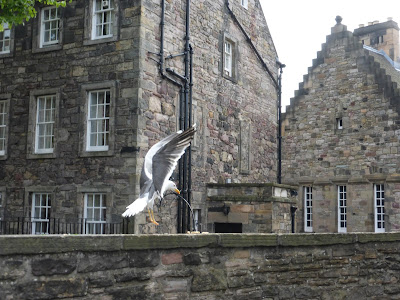On Monday, we took a bus to the city center, then a taxi up the hill to see the famed Edinburgh Castle. The castle stands like the fortress it is, breathtaking, and with a commanding vantage over the sea and the surrounding land. I wasn't fond of the crowds, but once in the castle, it is so expansive that it didn't seem so suffocating.
Edinburgh Castle sits on Castle Rock, a volcanic plug landform. A volcanic plug, also called a volcanic neck or lava neck, is a volcanic landform created when magma hardens within a vent on an active volcano. Archaeologists have established human occupation of the rock since at least the Iron Age (2nd century AD).
These having Lunch with us at the Castle
Before catching the bus back to our lodging, we took a turn through the National Gallery
Then tomorrow we would see Rosslyn Chapel
On Tuesday we braved the city traffic and drove outside of Edinburgh to Rosslyn Chapel, the chapel made famous by Dan Brown's novel, 'The DaVinci Code.' It truly is a remarkable place, and like the castle, steeped in rich history. The chapel had been neglected and had fallen into disrepair over the years since it's heyday. Not the least of the issues was that the massive stone structure had absorbed the humidity and precipitation of the centuries. It had been quite a project to dry the place out, which must be done from the inside out while it is protected from the elements.
Every square inch, inside and out, is adorned with intricate and symbolic carvings. It is truly magnificent! And of course the perfect place for the climactic scene in Dan Brown's book. You could come here a thousand times and not see, let alone understand, all the mysteries and symbolism. It took decades to build and has stood here for centuries.
We had asked a docent inside some questions and he was only too happy to tell us fun tidbits about this remarkable structure. As we were leaving, he saw us outside taking some more photos and approached us to regale us with some more stories, being careful not to place emphasis on any particular religious or mystical beliefs about the place. And he told us the story of the bees.
Seen below, this flower carved into the stone had for centuries (it is presumed) been a beehive. During the drying-out and maintenance, the bees had of course fled. Now, some years after the workmen were gone and things had settled down, the bees had just this summer returned. He was beaming! It had come full circle, another of nature's cycles. The bees had returned! We left feeling very good... and with this photo Jan managed to get of the 'beehive' with two bees visible. The bees had returned!
Notice the corn carved into the lintel of the window below. This is an early indication that corn (maize) had been a staple here centuries ago, as it was in the Americas and elsewhere in the world, as man emerged from a hunter-gatherer lifestyle.
The carving below known as 'The Green Man' is found countless times throughout the chapel, and though very little is known about it, much is supposed. I was intrigued with it since I had painted a picture in a college painting class that is very much the same, and I had titled it... wait for it... The Green Man! I bought a book about it as we were leaving, and intend to read it and drag my painting out of the closet for a look. The Green Man has returned!
Perhaps the most intriguing story of this chapel is of 'The Apprentice Pillar,' pictured above and below. Paired with the other 'Master' Pillar, and standing behind and to the sides of the altar, the pillars had both structural and architectural significance. The master stonemason had carved the pillar you see on the left, and the powers-that-be were less than impressed. So the mason had set out to tour the world and find inspiration before carving the second pillar. In his absence, his apprentice had had a dream that compelled him to carve the pillar himself. It is amazing in it's intricacy, it's symbolism, and it's execution. Upon his return, the master mason saw the pillar and realized how perfect it was. He flew into a jealous rage and struck the apprentice, killing him. A small carving of the master mason's head sits high on the wall at the rear of the church such that it is doomed to stare at the perfect pillar for eternity.
Carved centuries ago, we see now that it accurately represents human DNA!
It had been an awe-inspiring two days visiting the Edinburgh Castle and the Rosslyn Chapel, both of them visually remarkable and steeped in history. Next, on to Oxford to meet a friend, and then home again.















































No comments:
Post a Comment